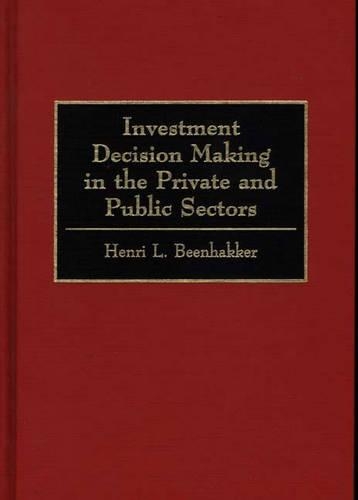
Investment Decision Making in the Private and Public Sectors
(Hardback)
Publishing Details
Investment Decision Making in the Private and Public Sectors
By (Author) Henri L. Beenhakker
Bloomsbury Publishing PLC
Praeger Publishers Inc
9th September 1996
United States
Classifications
Tertiary Education
Non Fiction
Budgeting and financial management
Public finance and taxation
658.15
Physical Properties
Hardback
264
Description
The analysis of investment decisions today draws upon a wide range of sources, from economics and finance to engineering economy and operations research. Dr Beenhakker's book reflects this interdisciplinary approach, and without assuming prior knowledge of these fields or a sophisticated understanding of mathematics, provides professionals and upper-level students with the concepts and tools they need to make enlightened investments in new ventures. Arranged to permit rapid review of an entire investment subject and written in a modular manner to allow readers to jump among chapters without losing their bearings, the book should help business managers deal intelligently with corporate financial and economic issues and government contracts. It should also help planners of the public sector incorporate the views of private industry in their own investment decision making. Dr Beenhakker begins wit a study of financial statements and ratios, and covers annual reports, balance sheets, income and retained earnings statements, cash flow statements, and financial ratios. In chapter 2 he looks at the valuation and investment problems when shares are under- or overvalued. He moves then to derivative securities, and in Chapter 4 to a discussion of diversification planning. In chapter 5 he takes up the costs of capital, with special attention to risk, uncertainty and in chapter 6 covers that and other topics in the context of project appraisal. Chapter 7 digs into programming and planning, and covers topics such as the marginal cost of capital in capital budgeting, the optimal capital budget, capital rationing, and economic development plans. The book ends with a discussion of cost minimization problems, such as leasing and purchasing, replacement investments, expansion investments, decision trees and the problem of how to ship quantities from supply to demand centres such that the total cost of transport is minimized. Five appendices provide readers with various tables and formulas to assist in their own calculations.
Reviews
Investment Decision Making in the Private Sectors reveals a subject so complex that one quails at the prospect of an entire book devoted to it. However, author Henri Beenhakker does a brilliant job in summarizing the details into a manageable book loaded with numeric examples and illustrations....The book has been written with impressive clarity, a book that I recommend to all publicly elected officials, all public and private finance directors, and to certified financial analysts (CFA) candidates.-Government Finance Review
"Investment Decision Making in the Private Sectors reveals a subject so complex that one quails at the prospect of an entire book devoted to it. However, author Henri Beenhakker does a brilliant job in summarizing the details into a manageable book loaded with numeric examples and illustrations....The book has been written with impressive clarity, a book that I recommend to all publicly elected officials, all public and private finance directors, and to certified financial analysts (CFA) candidates."-Government Finance Review
Author Bio
HENRI L. BEENHAKKER is a principal economist at the World Bank and Adjunct Professor, School of Advanced International Studies, Johns Hopkins University. With professional experience in economics, finance, and engineering, he has assisted major industrial and governmental organizations here and abroad in their long-range planning. Dr. Beenhakker has served as Chairman, Department of Industrial Management, University of Iowa, and was also employed by Stanford Research Institute. He is the author of four textbooks and more than 35 articles published in leading business and economics journals.
